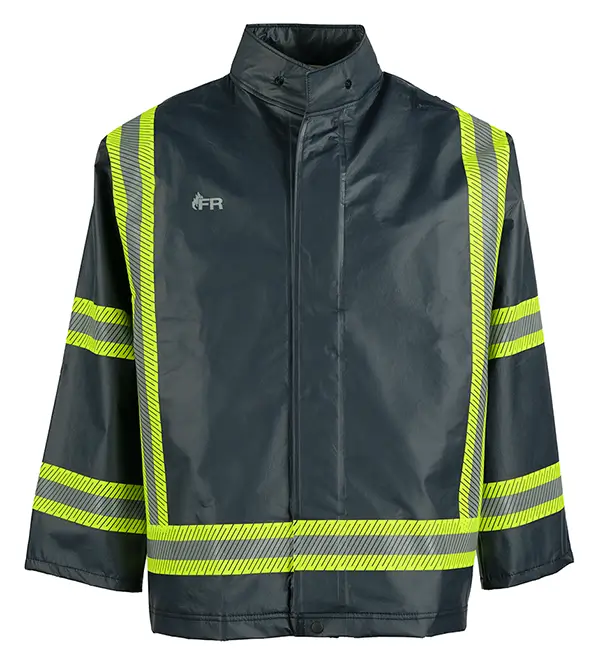Not all gear labeled “FR” is built the same. For linemen, gas utility workers, oil crews, and anyone working in high-risk environments, that label can be misleading—and dangerous.
Many rainwear brands throw “FR” on their products, but they’re only offering limited flame resistance, just enough to meet the bare minimum. This can give workers a false sense of safety. In real-world conditions, limited protection isn’t protection at all.
If your crew is wearing gear in the rain, around energized equipment, or near potential flash points, here’s how to make sure that “FR” actually means something.
1. Check for Compliance with Industry Standards
Authentic FR rain gear meets established safety standards from organizations like:
- ASTM F2733: Flash fire protection
- ASTM F1506: Arc flash and flame resistance
- OSHA 1910.269: Electric power generation and transmission safety
If your raincoat doesn’t list which standards it meets, or if it only says “FR” without specifics, you’re likely looking at limited-FR, not certified protection.
Our FR Rain gear is engineered to meet and exceed these standards, giving crews the confidence they need in high-risk conditions.
2. Understand What “Limited-FR” Really Means
“Limited-FR” gear is simply a vertical flame test. It may not melt or drip during a short exposure, but it’s not meant for real flame, arc flash, or repeated risk. It is only intended to measure the ability of the material to self-extinguish. As long as the flame is present, it may continue to burn. Many materials meet this requirement by simply melting away from the flame.
Limited-FR often does not meet NFPA or ASTM standards and may only pass basic flammability tests under lab conditions.
This is fine for low-risk tasks, but not for electric utility work, gas line maintenance, or storm response. If a spark, arc, or heat source lasts more than a second or two, limited-FR gear can fail fast.
3. Look at the Construction, Not Just the Label
Authentic flame-resistant rain gear is built with:
- Flame-resistant fabrics that self-extinguish
- Non-melting components
- Strong seam construction for durability
- Rain protection without compromising safety
On the other hand, many limited-FR garments use thin coatings or treated layers over cheap base fabrics. They look like rainwear, but they’re not made for the hazards your team faces.
BONUS TIP: 4. Don’t Settle for Marketing Claims
If you’re buying rain gear with only the word “FR” printed on the tag, you’re taking a risk. Some companies rely on the confusion between limited-FR and true FR to sell low-cost products that don’t protect in critical moments.
NASCO doesn’t play that game. We build outerwear that meets the real demands of utility, oil, gas, and electrical crews, day in and day out.
What to Look for Instead:
- Clear reference to ASTM certifications
- HiVis ANSI Class 2 or 3 for visibility and compliance
- Built-in coverage like hoods and storm flaps
- Durable construction made for extended field use
- Gear backed by a brand that serves real utility professionals
Final Word: Limited Doesn’t Mean Safe
Don’t let your crew rely on a label that only checks the minimum boxes. Authentic FR gear protects in real conditions.

NASCO Industries PetroStorm is designed to be the lightest weight multi-hazard protective outerwear available. With both flash fire and arc protection, PetroStorm is great for Upstream and Downstream Oil & Gas operations. It offers multi-hazard protection in a comfortable, lightweight, functional design.
Ready to Upgrade Your Rain Gear?
Don’t get stuck with limited-FR. Give your crew the protection they need. Shop NASCO’s complete line of high-performance outerwear now!

Recent Comments